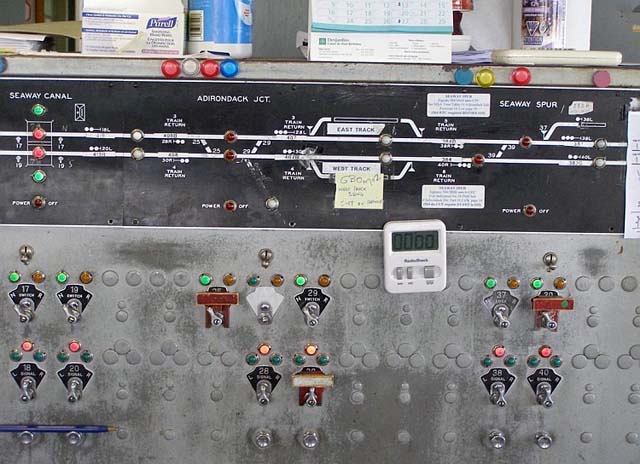|
Traffic control board for Seaway Interlocking - Date/Photographer unknown - TSB.
13 November 2013
Manually Operated Rail Traffic Control Systems Do Not Provide a Robust Defense Barrier Against Unprotected Overlap of
Authorities
Gatineau Quebec - The Transportation Safety Board of Canada (TSB) today released its Investigation Report R12D0063 into the September 2012 incident
involving an unprotected overlap of authority in Montreal, Quebec.
On 13 Sep 2012, Agence metropolitaine de transport (AMT) commuter train No. 94 (operating without passengers) was issued a written authority to pass stop
signal 383C located at Mile 38.3 within the Seaway Interlocking, near Montreal, Quebec, and to proceed northward on the west track of Canadian Pacific's
Adirondack Subdivision.
At about the same time, AMT commuter train No. 93 (operating with passengers) received a permissive signal at Mile 40.8 to proceed southward and to cross over
onto the same track as train No. 94.
As a result, both trains had authority to occupy the same portion of track, in opposing directions.
However, the overlap of authority was identified, and the situation was protected.
The Seaway Interlocking control system was installed in 1959.
Since its installation, there have been no significant changes to how this control system operates.
The traffic control board in the Seaway tower is manually operated by the signalman who controls track movements and protects track maintenance activities
through the interlocking.
Unlike more modern rail traffic control systems that provide additional defence barriers, the Seaway Interlocking Control System has no associated software
logic to trigger automatic blocking or to provide a text-based prompt when there are conflicting movements.
Modern computerized rail traffic control systems provide a defense barrier against certain errors that can lead to unprotected overlap of
authorities.
In these more modern systems, electronic blocking is automatically generated when the Rail Traffic Controller selects the proposed limits for the
authority.
AMT has started an upgrade project to replace the old Code System (i.e., Seaway Interlocking control system).
This project is scheduled for 2015.
Author unknown.
|

